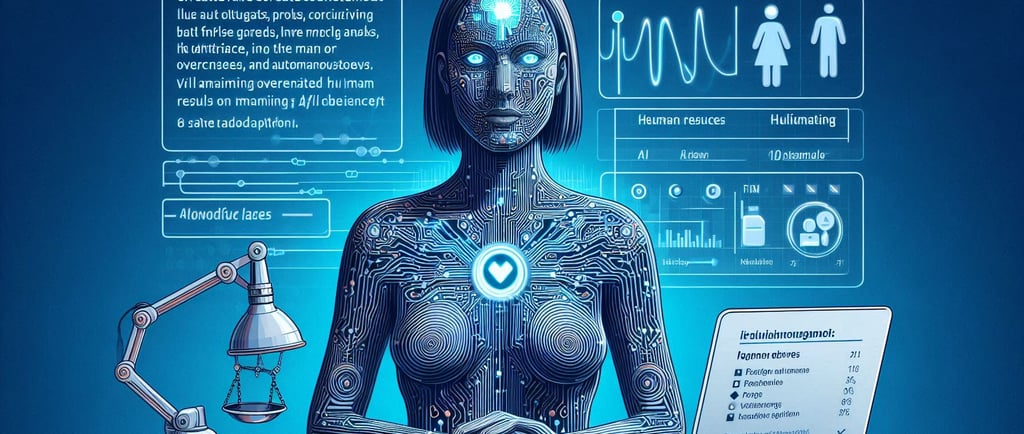AI Hallucinations: When Intelligent Machines Imagine What Isn’t There
AI hallucinations occur when artificial intelligence systems generate outputs that appear convincing but are factually incorrect or entirely fabricated. These errors can range from harmless mistakes, like mislabeling images, to life-threatening failures in areas such as autonomous driving, healthcare, and legal decision-making. Mitigating these risks requires high-quality training data, human oversight, and careful verification of AI-generated outputs.
HALLUCINATIONS
The AI Maker
8/14/20252 min read


Artificial intelligence (AI) has become a ubiquitous presence in modern life, powering everything from chatbots and image generators to autonomous vehicles and medical transcription software. But alongside its remarkable capabilities comes a troubling phenomenon: AI hallucinations. Much like the human experience of perceiving something that isn’t there, AI hallucinations occur when a system produces outputs that seem believable but are factually incorrect or entirely fabricated.
These hallucinations span across multiple AI domains. Large language models (LLMs), such as ChatGPT, are particularly prone to generating text that appears authoritative yet is misleading or false. A widely publicized example occurred in 2023 when a New York attorney submitted a legal brief partially drafted with ChatGPT; the document cited fictional court cases, a mistake that could have derailed proceedings if the judge hadn’t noticed. Similarly, image recognition systems like DALL·E can mislabel visual content, creating risks in high-stakes applications like autonomous driving. A self-driving car that misidentifies an object—or fails to identify it at all—could lead to catastrophic consequences.
The causes of AI hallucinations lie in the technology’s very foundation. AI models are trained on massive datasets and learn to identify patterns within that data. When presented with unfamiliar input, the model often attempts to “fill in the gaps” based on what it has seen before. This can produce comical but instructive errors, such as mistaking a blueberry muffin for a chihuahua, a classic illustration from computer vision research. In noisy or ambiguous environments, speech recognition AI may even insert entirely fabricated words, a problem that could prove serious in medical, legal, or law enforcement settings.
Importantly, hallucinations are distinct from intentional creativity. When an AI is tasked with generating a story, painting, or piece of music, novelty is the goal, and the unexpected is celebrated. But when the system is expected to deliver factual results, hallucinations are a failure mode—one that can have life-altering consequences if left unchecked. This is particularly true in areas where AI is influencing high-stakes decisions, from healthcare diagnostics to social service eligibility to military targeting systems.
Companies developing AI tools, including OpenAI, Anthropic, and autonomous vehicle leaders like Tesla, are investing heavily in strategies to mitigate hallucinations. Approaches include curating higher-quality training data, constraining outputs through stricter model alignment, and incorporating human-in-the-loop validation. Still, as AI continues to integrate into critical infrastructure and decision-making, hallucinations remain a persistent risk that cannot be fully engineered away.
For users and organizations, vigilance is essential. Blindly trusting AI-generated outputs can lead to misinformation, operational errors, or even physical harm. The safest approach is to treat AI as an assistant, not an authority. Cross-verifying AI responses with reliable sources, leveraging expert review for sensitive tasks, and understanding the technology’s limitations are key practices for responsible adoption.
As AI grows more capable, society must grapple with the paradox of its potential: the same systems that promise unprecedented efficiency and insight can also conjure errors out of thin air. Recognizing and mitigating AI hallucinations is not just a technical challenge—it’s a prerequisite for building trust in the future of intelligent machines.
Cited: https://theconversation.com/what-are-ai-hallucinations-why-ais-sometimes-make-things-up-242896
Your Data, Your Insights
Unlock the power of your data effortlessly. Update it continuously. Automatically.
Answers
Sign up NOW
info at aimaker.com
© 2024. All rights reserved. Terms and Conditions | Privacy Policy
